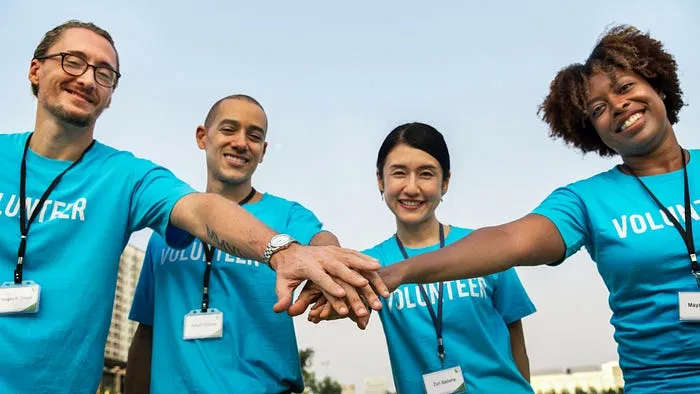The foundation of every nonprofit is people. The founders who saw an opportunity and envisioned an organization that could help, the employees and volunteers who keep operations running smoothly, the donors and patrons who fund the efforts and spread the word, and the beneficiaries whose lives are improved.
As a nonprofit your product is smiles and lives and livelihoods as opposed to dollar signs and, while that does make it easier to get up and head “off to work” in the morning, it also carries its own collection of challenges.
In an always-connected world, where instant, personalized service has become the expectation not the exception — relationship management is more important than ever. Fears about cost, complexity, adoption, and justification can make a CRM (customer relationship manager) seem like an impossible dream. Luckily, you’re not alone. In today’s post we’ll take a look at Salesforce, the reasons it’s the number 1 choice for nonprofits all over the world, and the best ways to leverage its functionality to super-power your org.
Let’s dive in!
Cost

I wish we could title this section differently, and it really shouldn’t be the first one because it’s hardly the “best reason” to roll out Salesforce — but cost is such an important consideration for nonprofits that I figured we should knock this out of the way first.
Salesforce donates 10 licenses to nonprofits!
In non-software-speak, that means nonprofit organizations get the system and 10 users free. And not a bare-bones system either, but Salesforce Enterprise. The same solution that usually costs $125 per user per month — so it’s a value (savings!) of $15,000 every year!
And seriously, Salesforce Enterprise is their flagship offering — it has so many amazing features. If CRMs were “lawn management tools”, SF Professional Edition would be a walk-behind lawnmower, and Enterprise Edition would be one of those Roomba mowers that automates your lawn care, can be managed from your phone, and includes pre-developed gardening solutions for weeding, watering, and garden-layout management. It’s a really impressive piece of software and we’ll get into exactly how it helps in a bit.
And those free licenses aren’t the only way Salesforce helps nonprofits keep more money for doing good. They also offer discounts on additional products, adding extra users, and many (probably most) of the third-party apps in the AppExchange also offer nonprofit discounts!
Ok, and now that we’ve got your cost concerns out of the way, we can focus on the ways Salesforce really empowers philanthropic organizations to be their best selves.
Visibility, Metrics, and Tracking — All Your Info in One Place

Everything you do matters. With finite resources and noble goals, wasted efforts are missed opportunities to better serve your cause. With Salesforce, you have the ability to track, record, and dive into any of your data, empowering you and your organization to make more informed decisions.
From insight and reporting into fundraising efforts, to tracking the progress of grant requests — all of your information and activities are in one place, in one system, and visible to whoever needs access. You can run reports on engagement, see which of your campaigns are the most successful, assign your employees to different activities, donors, and/or households to avoid duplicated efforts, and get a 360-degree view of your whole organization. Not to mention the ability to better predict what kind of donation pipeline you’re looking at for the next quarter, year, etc… to help you better plan your future.
No more separate excel spreadsheets, and dropbox folders, and waiting for “Mark” to get back from holiday so you can get an update on that letter of intent he sent out — it’s all right there, unifying your staff’s efforts and streamlining every step of the process.
The Salesforce Community — An Ohana of Helpers

Salesforce isn’t just the most widely-used and most steadily-growing CRM, it’s also home to the largest community of willing helpers, on- and offline. Everyone in the Salesforce community is considered a part of their Ohana, the Hawaiian concept of family. Employees, partners, customers, and fans all form a community providing helpful questions and answers, live and online training courses, resources, and support — you’ll be hard-pressed to find an issue someone else hasn’t faced already, coupled with a handy guide for accomplishing whatever it is you’d like to do.
With sub-communities specializing in everything from 501Cs to 401Ks, you can ask for help from the users and admins who have experience sitting right where you are, at any stage of your deployment. Community events help organizations network, share best practices, and get direct help and advice.
Beyond user-groups, there are also Salesforce and partner driven seminars, both in-person and online, to walk you through everything from basic to advanced functionality and there’s an entire online learning system in Trailhead that has handy guides for every user and role neatly organized into learning paths!
And if you still can’t find a way to make Salesforce do “that one specific thing”, there’s the AppExchange. The original App Store (seriously, they gifted the name to Apple when the iPod rolled out), it’s a collection of the most useful add-ons developed by Salesforce, third-parties, and users themselves. Integrations with other systems, pre-built data dashboards, industry-specific workflows, and more. Even better, most are free or discounted for nonprofits just like you!
It’s pretty incredible, but it’s also easy to see what keeps organizations coming back to Salesforce — it’s the most supportive CRM out there!
Automation and Effort Multiplication

Ever wish you had an assistant? Or better yet, a clone? A spare version of you that knew all the same stuff, did things the same way, and could come in an hour or two early every day to take care of all the boring stuff you have to spend time on before you get into the “meat” of your work? Now you can!
We all have parts of our workflow that aren’t “productive” themselves, but that make us more productive. Organizing the list of donors and phone numbers for “thank you” calls, planning the day/week/month and updating the sticky notes all over our monitor, divvying up the assignments for the fundraiser to make sure everybody knows what they’ll be responsible for etc… While Salesforce’s cloning module may still be a ways away, you can use it to automate all of those “work prep” activities, leaving your true self free to focus on the actions that really have an impact.
Salesforce can keep everyone in the loop on campaigns and pledge drive progress by distributing automated reports and dashboards. You can auto-assign roles on projects or have new donors automatically assigned a rep and instantly schedule a “thank you” call on their calendar. Basically, if it’s an if/then where, “when A happens, I do B or C and then Z”, you can have the system handle everything up front, so when you arrive in the morning your day is already planned — a series of Zs ready to go because Salesforce handled the ABCs already!
And beyond automation, Salesforce can multiply your efforts — giving you the power of several “you”s! Create email templates and macros for mass outreach that feels individually personal, design and deploy chat functionality with AI driven by your own common responses, create a localized fundraising campaign that can be adapted and rolled out in every one of your relevant communities.
Imagine how much more you could accomplish with another “you” handling the grunt work. And now imagine all your coworkers with their own extra “them”s. That’s the power of Salesforce — it’s not about getting more done with less people or replacing people with systems, it’s about helping everyone on staff do more good by multiplying their efforts, and automating those non-mission-critical but definitely-day-to-day-critical activities.
Build your Own Community

Self-service, personal involvement, and community engagement are no longer extraordinary features, they’re 21st century expectations. Necessities. Whether it’s a portal to connect your donors with giving opportunities and event information, or a place for your volunteers to sign-up, schedule, plan, and share upcoming campaigns and efforts, or a one-stop-site for your beneficiaries to enroll in your services, learn more about your organization, and find additional help — web-based communities are a powerful tool for nonprofits to expand their effective reach.
With Salesforce Experience Cloud, rolling out online communities is easier than ever. With your branding, your messaging, and your functionality — all without having to worry about how to code accounts, passwords, usernames, etc… .
You can enable your communities to share info and files, collaborate on projects, answer each other’s questions, plan events, and more — online and on their mobile phones. You can easily restrict communities too (or restrict access to certain items and fields inside communities), so it’s easy to deploy specific spaces for donors, staff, volunteers, and beneficiaries!
Communities are a fixture of modern nonprofits, private brands, and organizations of all shapes and sizes — they’re a powerful tool for enfranchising everyone involved in your cause and, with Salesforce, capturing that value and effectiveness is easier than ever!
Nonprofit Success Pack

Want to get started ASAP? The Nonprofit Success Pack (NPSP) is designed to help you and your org do just that! The NPSP is an open-source addition to Salesforce that comes “pre-baked” with industry-standard architecture, constituent and donor management components, and was designed and built by nonprofits to help others get up and running quickly, seamlessly, and inline with industry best practices.
The NPSP enables organizations to manage donations, memberships, relationships, and company affiliations right out of the box, as well as gifts, recurring payments and so much more. And at MK Partners we’re especially well-equipped to help organizations get it rolling smoothly because some of our team helped develop the original NPSP in the early days of Salesforce!
Reach Out Everywhere

Nowadays, your customers are everywhere. They’re still calling and writing (though less than they used to), but they’re also tweeting, ‘gramming, facebook live-ing, they’re hitting you up on messenger, whats app, and sliding into your DMs. And if you’re not responding (or even worse, not present) you’re missing out on a huge chunk of your potential.
The concepts of “business channels” and “business hours” are fading to the same forces that claimed the phrase “please wait six to eight weeks for delivery”. What customers used to consider an unavoidable inconvenience of doing business has transformed into an expectation that businesses will be where their customers are — or miss out on the conversation.
Luckily, Salesforce makes keeping in touch easy, across all channels. Email management for campaigns make mass reach-outs a breeze, and segmented lists allow you to narrow down to more personalized messaging for select groups based on region, recent activities, and more. SMS messaging is an amazing tool for event-day notifications, keeping your staff in sync on busy days, at off-site events, or in big campaign pushes — it’s also a great tool for driving engagement, getting feedback, and staying top-of-mind with your donors. And Salesforce also help organizations stay on top of social media mentions, posts, and related tags — so you can always meet your target audience, wherever their talking about you and your cause.
Salesforce Cares and Creates a Culture of Caring

The last, but perhaps most significant, reason Salesforce is such a boon to nonprofits is that Salesforce really cares. Like, really really cares. They pride themselves on the charitable culture they produce in the workplace, the good work they do in their own communities, and the help they provide nonprofits everywhere to maximize their effectiveness.
That’s why Salesforce developed the Nonprofit Success Pack and why they have a team of dedicated support staff focused on getting new nonprofits up and running quickly! Instead of treating charitable orgs as “nice-to-have-but-non-revenue-generating-afterthoughts”, Salesforce treats their charitable clientele with the attention, care, and gratitude of a company that really cares about doing good.
In fact, Salesforce founded their own philanthropic movement with the Pledge 1% campaign that first rolled out as an internal goal for corporate giving, and has since expanded to a group of more than 1,000 companies — all of whom pledge to donate 1% of their time, products, and/or revenue to charitable causes. At MK Partners that translates to revenue donations, service donations to nonprofit clients, and monthly employee volunteer days at organizations all over Los Angeles!
Couple all that goodness under a brand-umbrella that loves to brag about their clients’ successes and boost their causes — and you’ll see Salesforce is a recipe for nonprofit success.

If you’re interested in learning more about how MK Partners can help your organization roll-out Salesforce, and how we’ve helped similar organizations in the past — give us a call! And if you’d like to do some more reading on the subject (or have something to show off to the higher-ups), check out this handy booklet on all the benefits of choosing a CRM that cares!
Until then, keep working hard, smart, and happy! We’ll see you in the cloud.

